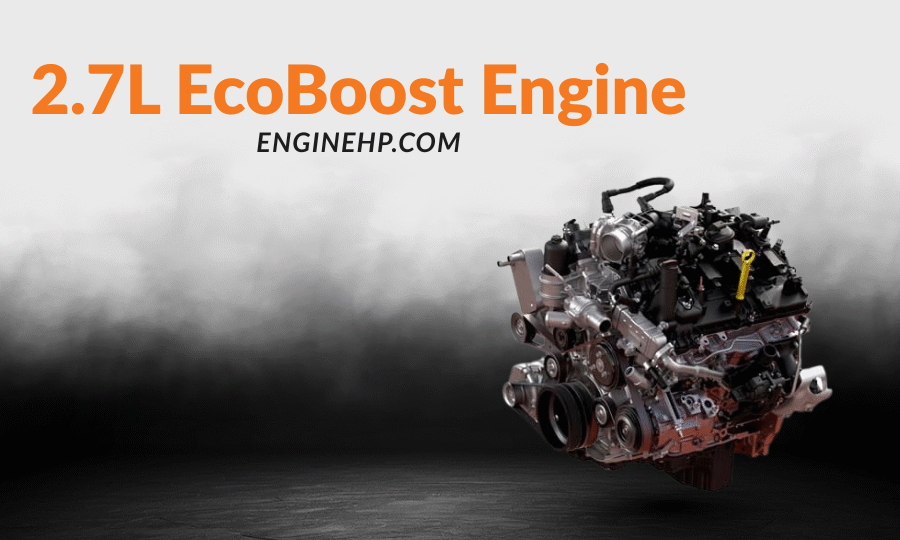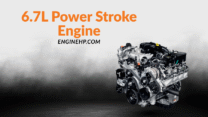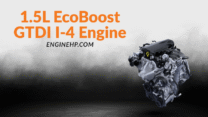
Ford Engines: 2.7L EcoBoost Engine Hp, Reliability, and Performance
Few things can compare to the balance of power, fuel mileage and advanced technology offered by the 2.7L EcoBoost in Ford. Be it fueling a complete-sized pickup truck or an SUV, such a turbocharged engine is not compromised on performance delivery. How does the 2.7L EcoBoost engine jump out compared to any other and what is it about this engine that makes it such a highly valued engine throughout the automotive industry in modern times? It is high time we had a closer look at the characteristics, performance and advantage of this amazing engine.
What is the 2.7L EcoBoost Engine?
EcoBoost is a series of engine used by Ford that are turbocharged and the 2.7L engine is a 6 cylinder engine. The explosive power-to-weight ratio and fuel efficiency with low emissions makes it impressively powered by Ford GTDI technology (turbocharging and direct fuel injection). The engine has been made to deliver both excellent performance and fuel consumption, a combination that makes it fit both working conditions and recreational activities, and a passenger favorite in trucks such as the F-150 and Edge.
The difference with the 2.7L EcoBoost, compared to the typical engine, is that the new engine operates using new technologies such as twin-turbochargers and advanced fuel injection systems to optimize its power output and reduce the amount of fuel consumed. It is designed to satisfy the need of contemporary drivers that want performance and environment friendly driving options.
Key Features of the 2.7L EcoBoost Engine
Twin-Turbocharging for Superior Power
And the Twin Turbochargers in the 2.7L EcoBoost increase the amount of air in the engine, pushing it to enable farther away combustion efficiency. This achieves much more power without having to have a larger engine. It is twin-turbocharging that contributes to high speed acceleration and the power capable of withstanding low engine speeds, such as the one that trucks and SUVs need to afford these vehicles heavy towing or hauling purposes.
Direct Fuel Injection (DFI) for Efficiency
One of the technologies the 2.7L EcoBoost engine utilizes most is direct fuel injection. Fuel is injected directly into the combustion chamber which makes the air-fuel mixture more accurate, which results in optimal combustion efficiency. The technology assists the engine to burn the fuel in a more efficient way which interprets to higher fuel efficiency and lesser emissions. The 2.7L EcoBoost motor would be capable of delivering an excellent performance in terms of power generation without causing a high carbon emission footprint.
Aluminum Alloy Block for Reduced Weight
Light weight aluminium alloy block has been one of the greatest unique features of the 2.7L EcoBoost. This minimizes overall weight of the engine thereby aiding in improved fuel efficiency, handling, and improved overall vehicle dynamics. Ford designers have ensured that durability does not pose a compromise on the engine weight by designing the engine in such a way that it is durable and that it performs better in a work vehicle.
Variable Valve Timing (VVT)
It has been fitted with variable valve timing (VVT), which finds the timing of the intake and exhaust valves according to driving conditions. This guarantees optimum engine performance at a variety of speeds and driving conditions. VVT helps provide better fuel delivery and combustion whether you are towing a heavy load or on the highway where smoother acceleration and efficient drive are ideal.
Integrated Exhaust Manifold
Ford has built the 2.7L EcoBoost engine having cast-in exhaust manifold. This minimises turbo lag through proximity of the turbochargers to the exhaust valves. This gives increased turbo spool time and acceleration when you most need it. It also allows improvement of the overall engine complexity and makes the engine more responsive.
Performance: How the 2.7L EcoBoost Handles Real-World Demands
The engine in the 2.7L EcoBoost delivers great performance with the advantage of having two worlds in one: power and efficiency. Power output coming in between 325-400 horsepower and torque levels between 400-500 lb-ft, this powerplant is as strong as most large engines yet significantly smaller and less fuel-thirsty.
The amount of torque produced in the 2.7L EcoBoost motor is quite remarkable especially in low-end capabilities. This is vital to the drivers that require their vehicles to tow a dense load or move a trailer, as its torque is needed to haul weight. The 2.7L EcoBoost also makes heavy-duty tasks easier and acceleration more effortless whether towing a boat, hauling equipment, or cruising in the highway.
The 2.7L EcoBoost is unique in its ranks in terms of fuel efficiency. It averagely gets consumptions of about 20-22 Miles per gallon in the urban areas and 25-27 Miles per gallons on the highway, again depending on the model of the propelled vehicle. This is one of the biggest avenues to be reached by an engine that produces power and capability that usually comes with engines that use more fuel.
2.7L EcoBoost Engine Specifications
| Specification | Details |
| Manufacturer | Lima Plant, Ohio, USA |
| Production Years | 2015–present |
| Cylinder Block Material | Compacted graphite iron |
| Cylinder Head Material | Aluminum |
| Fuel Type | Gasoline |
| Fuel System | Direct injection (2015–2017) |
| Configuration | V |
| Number of Cylinders | 6 |
| Valves per Cylinder | 4 |
| Valvetrain Layout | DOHC |
| Bore (mm) | 83.0 mm (3.27 in) |
| Stroke (mm) | 83.0 mm (3.27 in) |
| Displacement (cc) | 2,694 cc (164 cu in) |
| Type of Internal Combustion Engine | Four-stroke, turbocharged |
| Compression Ratio | 10.3:1 |
| Power (hp) | 315–335 hp (235–250 kW) @ 5,000–5,750 rpm |
| Torque (lb-ft) | 350–400 lb-ft (475–542 Nm) @ 3,000–3,250 rpm |
| Engine Weight | – |
| Firing Order | 1-4-2-5-3-6 |
| Engine Oil Capacity (liter) | 5.7 l (6.0 qt) – with oil filter |
| Engine Oil Weight | SAE 5W-30 full synthetic motor oil (Oil recommendations and capacity may vary depending on the car model, year, and market. Please check the service manual specific to your vehicle!) |
| Oil Change Interval (mile) | 10,000 miles (15,000 km) / 12 months |
| Cars with This Engine | Ford F-150, Ford Bronco, Ford Edge Sport, Ford Edge ST, Ford Fusion Sport, Lincoln MKX, Lincoln Continental, Lincoln Nautilus |
Why Should Buyers Consider the 2.7L EcoBoost Engine?
Towing Capacity and Hauling Power
Towing and hauling is one of the strongest arguments in buy reasons customers prefer the 2.7L EcoBoost engine. As an example, in the Ford F-150 the 2.7L EcoBoost engine has been rated to tow 8,500 pounds when properly configured. This aspect makes it a perfect option to people who require a truck which could meet the requirements of daily working and leisurely use like towing trailers, boats or heavy loads.
Efficiency Meets Performance
The 2.7 L EcoBoost engine will be a great choice to those buyers unwilling to give up fuel efficiency to enjoy power. Its twin-turbo includes the direct injection which enables it to provide a high powered engine comparable to that of a larger engine but at the same time it manages to have an excellent fuel economy. Regardless of whether you use your vehicle during long commutes or weekend getaways, this engine would mean that you would not have to spend a lot of time at the pump without compromising the performance you require.
Eco-Friendly and Emission-Conscious
Given the increase of environmental awareness among the population, more consumers are turning toward vehicles with low emissions. The 2.7 Litre EcoBoost engine, through direct fuel injection technology and turbocharged technology, is much lower in carbon emissions than larger engines that are naturally aspirated. To appealing customers concerned about the environment, the 2.7L EcoBoost is a more efficient, cleaner and does not fall short in power.
Smooth Driving Experience
The 2.7L EcoBoost has features that include variable valve timing as well as integrated turbochargers which provide smooth acceleration and a sophisticated driving experience. All of that engine power is delivered just when you need it, whether it is getting you through city traffic or on down the highway.
Affordable Maintenance
In comparison to the larger more complicate engines, the 2.7L EcoBoost is easy to maintain. This lightweight with efficient engine parts translates into less repair and long engine life. Further, because of the large number of vehicles with the 2.7L EcoBoost that Ford produces, the mechanical parts can be replaced with ease and at a low cost making it a very economic choice of vehicle ownership in the long-term.
The 2.7L EcoBoost Engine in the Automotive Industry
The 2.7L EcoBoost engine is a significant feature in the company of Ford that believes in offering its consumers high-performance, environmentally friendly and efficient cars. Solid power and superior fuel-efficiency level make it an appealing choice to an even broader audience, as it can be used both to help it tow goods around and as a reliable everyday driver.
The 2.7L EcoBoost engine will enable companies operating in automotive industry to provide products that to consumers that are competitive and respond to changing needs of the consumers. Providing a fuel-efficient, yet powerful engine, Ford can continue to dominate the market and attract more people as well, not only the traditional truck-loving individuals but environmentally-aware people too.
Moreover, the engine has garnered popularity among all kinds of vehicle classes, whether full-sized trucks such as F-150 or the mid-sized SUVs, like the Ford Edge, due to its capacity to balance between fuel efficiency and power.
Where Can You Find the 2.7L EcoBoost Engine?
The popular models that are equipped with 2.7L EcoBoost engine include the following:
- Ford F-150: This is one of the most sold trucks in America and the towing capability of the 2.7L EcoBoost makes it an ideal choice whether at work or during leisure time.
- Ford Edge:The Edge is an extremely capable SUV that makes use of the 2.7L EcoBoost powertrain to provide outstanding efficiency with its V6 power.
- Ford Explorer: This family car is all power and space, which gives the 2.7 L EcoBoost a powerful punch inside the vehicle with its strong acceleration and towing characteristics.
- Ford Lincoln MKX: The sedan equivalent to the Ford Edge, MKX is based on the 2.7L EcoBoost, which provides it with the sleek performance and a high level of comfort.
Challenges and Considerations When Buying a 2.7L EcoBoost Engine Vehicle
Although the 2.7L EcoBoost engine is resourceful in a number of ways, there are certain aspects that consumers need to take into consideration:
Preferred Fuel Specification
The development of some models with 2.7L EcoBoost engine requires high-quality fuel. Although this is not a significant consideration by most consumers, it can become expensive over the years.
First Purchase Price
The prices of vehicles powered by the 2.7L EcoBoost may also be high in case of initial prices in comparison with smaller less powerful ones. But that is usually compensated with discounted future fuel costs and better performance.
Probable turbo lag
Although the bespoke structure reduces turbo lag, drivers may still find that there is slight delay when accelerating in particular driving scenarios.
Conclusion: Is the 2.7L EcoBoost Engine Right for You?
The 2.7L EcoBoost offers a great performance that is flexible and adaptable to the demands of any particular driver since it is powerful enough to support the larger engine and fuel efficient and low emissions of a smaller engine. No matter what could be the case of the need to work with a truck, or you need an SUV daily, the 2.7L EcoBoost will offer an excellent combination of power when it is required and efficiency and endurance. Should you desire an engine that hits both worlds, then 2.7L EcoBoost is something to consider.










Leave a Reply